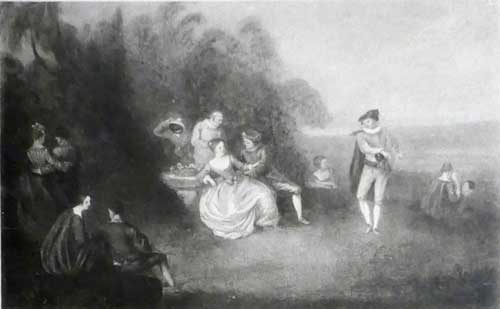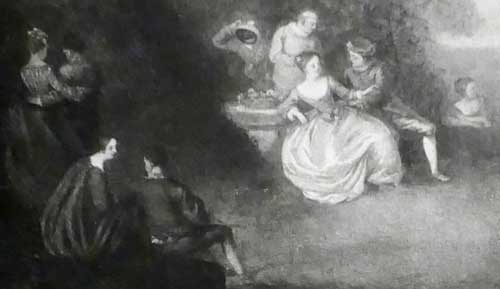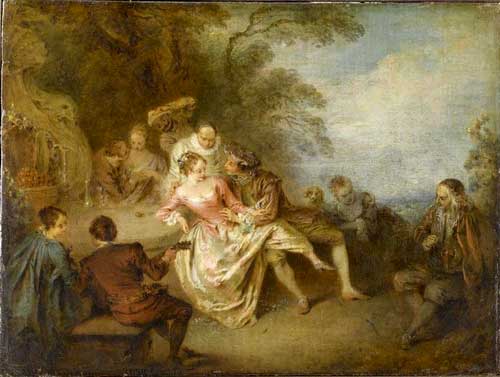
- Home Page
- Accepted
Paintings & Copies - Doubtful
Attributions - Doubtful Textual References
- Alternative
Titles - Collectors &
Museums - Bibliography
- Search Abecedario
- Watteau &
His Circle
X. Schäferromantik
Entered August 2017
Whereabouts unknown
Oil on canvas
55 x 85 cm
PROVENANCE
Mannheim, collection of Prince Karl Theodor von der Pfalz (1724-1799).
Mannheim, private collection; sale, Munich, Galerie Helbing, October 12, 1909, cat. 63: “SCHULE DES ANTOINE WATTEAU . . . Schäferromantik. Auf einer Rasenfläche vor dem Baumschlag ist eine Gesellschaft von jungen Damen und Kavalieren versammelt; die Damen in ländlichen Kostümen, die Kavaliere in Barett, Halskrausen, kurzen Jacken und Kniehosen, zwei von ihnen as Pierrots gekleidet; ein Liebespaar sitz bei einer Steinbrüstung, auf der ein Blumenkorb mit Rosen niedergesetzt ist, drei andere Paare konversieren. Ein Kavalier im Vordergrund füllt ein Weinglas au seiner dickbauchigen Flasche. Im Mittelplan fällt der Rasen in die tiefer liegende Flusslandschaft, die an das Seinetal erinnert, ab, so dass eine hier Stehende Dame nur im Brustbild erscheint. Die Konturen der Ferne verschwimmen im Dunst des schönen Sommertages. Leinwand. Höhe 55 cm, Breite 85 cm. Goldrahmen. Abbildung Tafel 44.”
REMARKS
Although the painting was attributed to the school of Watteau when it sold in Mannheim in 1909, it would have been more accurate to have ascribed it to the school of Pater. Almost nothing in this composition relates specifically to Watteau, but there are many resonances with Pater’s established oeuvre. The central group of the man courting a woman, a Pierrot and Harlequin behind them, a second courting couple farther back, and a man serenading a woman in the lower left foreground—this entire ensemble is based on a Pater painting now in the Louvre known as La Feste italienne.
Although there are these undeniable correspondences with Pater’s established oeuvre, this picture is decidedly weak in terms of its figures and its loose composition. It appears to be the work not of a shop assistant but an imitator, and at some distance from Pater.
A provenance from the collection of Prince Karl Theodor von der Pfalz was claimed for all the works sold in Mannheim in 1909.


